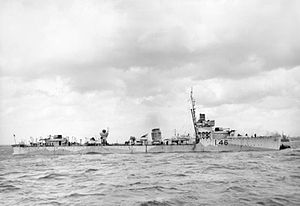HMS Winchelsea (D46) was an Admiralty W-class destroyer of the Royal Navy, ordered 9 December 1916 from J. Samuel White at Cowes during the 1916–17 Build Programme.
 Winchelsea during World War II
| |
| History | |
|---|---|
| Name | HMS Winchelsea (D46) |
| Ordered | 9 December 1916 |
| Builder | J. Samuel White |
| Laid down | 25 May 1917 |
| Launched | 15 December 1917 |
| Decommissioned | March 1945 |
| Fate | Scrapped August 1945 |
| General characteristics | |
| Class and type | W class destroyer |
Winchelsea was launched on 15 December 1917 and was the 7th Royal Navy ship to carry this name, introduced in 1694 and named after the 6th Earl of Winchilsea (1647–1730)[1]
In March 1945 she was decommissioned and sold for scrap.[2]
Events in history edit
September 1939 — with the 11th Destroyer Flotilla.
26 May–4 June 1940 — the Dunkirk evacuation, code-named Operation Dynamo.
27 July 1940 — 84 survivors from the British freighters Sambre and Thiara were picked up. They had been torpedoed and sunk by the German submarine U-34 (1936), south-south-west of Rockall.
13-17 September 1940 — Escorts Convoy OB 213. After Winchelsea leaves, two ships in the convoy, including the child evacuation ship SS City of Benares, were attacked by a submarine. 260 people, including 258 passengers and crew from the Benares, are killed.
17 September 1940 — 25 survivors from the British freighter Crown Arun were picked up after the ship had been torpedoed and then sunk with gunfire by the German submarine U-99, north of Rockall.
2 November 1942 — 24 survivors were picked up after the British freighter Hartington had been torpedoed and sunk by U-521, approximately 450 nautical miles (830 km) east of Belle Isle.[3]
See also edit
Notes edit
- ^ "HMS Winchelsea (D46)". Retrieved 13 December 2007.
- ^ "Wakeful Class". Retrieved 13 December 2007.
- ^ "HMS Winchelsea (D 46)". Retrieved 13 December 2007.
Bibliography edit
- Campbell, John (1985). Naval Weapons of World War II. Annapolis, Maryland: Naval Institute Press. ISBN 0-87021-459-4.
- Chesneau, Roger, ed. (1980). Conway's All the World's Fighting Ships 1922–1946. Greenwich, UK: Conway Maritime Press. ISBN 0-85177-146-7.
- Colledge, J. J.; Warlow, Ben (2006) [1969]. Ships of the Royal Navy: The Complete Record of all Fighting Ships of the Royal Navy (Rev. ed.). London: Chatham Publishing. ISBN 978-1-86176-281-8.
- Cocker, Maurice. Destroyers of the Royal Navy, 1893–1981. Ian Allan. ISBN 0-7110-1075-7.
- Friedman, Norman (2009). British Destroyers From Earliest Days to the Second World War. Annapolis, Maryland: Naval Institute Press. ISBN 978-1-59114-081-8.
- Gardiner, Robert & Gray, Randal, eds. (1985). Conway's All the World's Fighting Ships 1906–1921. Annapolis, Maryland: Naval Institute Press. ISBN 0-85177-245-5.
- Lenton, H. T. (1998). British & Empire Warships of the Second World War. Annapolis, Maryland: Naval Institute Press. ISBN 1-55750-048-7.
- March, Edgar J. (1966). British Destroyers: A History of Development, 1892–1953; Drawn by Admiralty Permission From Official Records & Returns, Ships' Covers & Building Plans. London: Seeley Service. OCLC 164893555.
- Preston, Antony (1971). 'V & W' Class Destroyers 1917–1945. London: Macdonald. OCLC 464542895.
- Raven, Alan & Roberts, John (1979). 'V' and 'W' Class Destroyers. Man o'War. Vol. 2. London: Arms & Armour. ISBN 0-85368-233-X.
- Rohwer, Jürgen (2005). Chronology of the War at Sea 1939–1945: The Naval History of World War Two (Third Revised ed.). Annapolis, Maryland: Naval Institute Press. ISBN 1-59114-119-2.
- Whinney, Bob (2000). The U-boat Peril: A Fight for Survival. Cassell. ISBN 0-304-35132-6.
- Whitley, M. J. (1988). Destroyers of World War 2. Annapolis, Maryland: Naval Institute Press. ISBN 0-87021-326-1.
- Winser, John de D. (1999). B.E.F. Ships Before, At and After Dunkirk. Gravesend, Kent: World Ship Society. ISBN 0-905617-91-6.